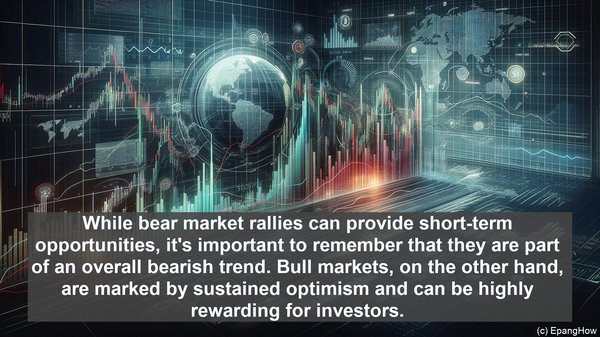Introduction: The Dynamic Nature of Financial Markets
Hello everyone, and welcome to our video on the intriguing world of financial markets. One of the most fascinating aspects of these markets is their ever-changing nature. Prices fluctuate, trends emerge, and investors navigate through various market phases. Today, we’ll be focusing on two such phases: bear market rallies and bull markets. While they may seem similar at first glance, there are crucial differences that every investor should be aware of. So, let’s dive in!

Bear Market Rallies: A Temporary Respite
During a bear market, which is characterized by a sustained decline in prices, there are occasional upswings known as bear market rallies. These rallies, often marked by a surge in prices, can give the impression that the market is turning around. However, it’s important to note that these rallies are typically short-lived and don’t signify a complete reversal of the bearish trend. They can be attributed to factors like short-covering or temporary market optimism. Investors need to exercise caution during such rallies, as the overall market sentiment may still be bearish.
Bull Markets: A Period of Optimism
In contrast, bull markets are characterized by a sustained uptrend in prices. They are typically marked by investor optimism, positive economic indicators, and increasing market participation. During a bull market, there may be occasional dips or corrections, but the overall trend is upward. These periods can be highly lucrative for investors, as the rising tide often lifts many stocks. However, it’s important to note that not all stocks or sectors may perform equally well during a bull market, and careful analysis is still essential.
Key Differences: Bear Market Rallies vs. Bull Markets
Now, let’s delve into the key distinctions between bear market rallies and bull markets: 1. Duration: Bear market rallies are typically short-lived, lasting anywhere from a few days to a few months. In contrast, bull markets can span several months or even years. 2. Market Sentiment: While bear market rallies may create a temporary sense of optimism, the overall market sentiment during a bear market remains negative. In a bull market, the sentiment is predominantly positive. 3. Price Movement: Bear market rallies are often characterized by sharp price increases, while bull markets see a more gradual and sustained uptrend. 4. Investor Behavior: During a bear market rally, some investors may be tempted to enter the market, hoping for a quick profit. In a bull market, investor participation is generally higher, with more people entering the market. By understanding these differences, investors can make more informed decisions and navigate the market’s twists and turns with greater confidence.

